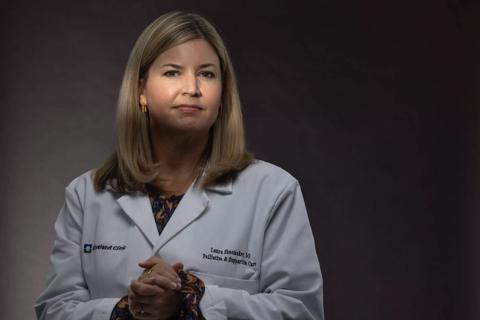Effective provider training strategies incorporate multi-modal delivery

Time is one of the most precious resources in healthcare, yet it often becomes a challenge for providers due to the demands of electronic health record (EHR) documentation.
Advertisement
Cleveland Clinic is a non-profit academic medical center. Advertising on our site helps support our mission. We do not endorse non-Cleveland Clinic products or services. Policy
Addressing this burden through tailored training strategies can significantly enhance provider satisfaction, efficiency, and ultimately, patient care.
“While better EHR usability boosts provider satisfaction, the added stressor of training can be overwhelming for already busy healthcare providers,” says Jean Vickers, MD, Cleveland Clinic Associate Chief Health Information Officer.
Providers’ demanding schedules leave little room for extensive training, but flexible and accessible formats can help bridge the gap. Cleveland Clinic’s approach includes self-paced e-learning modules, tip sheets, video tutorials and monthly ‘tune-up’ sessions, which allow providers to engage with training materials at their convenience.
“Our training programs are designed to meet providers where they are by offering training that is accessible, time-efficient and clearly shows value to their daily work,” says Dr. Vickers.
Tailoring training to specific roles and departments, and using examples that reflect providers’ actual day-to-day tasks, ensures that the content is practical and immediately applicable.
“Breaking training into smaller segments that focus on specific tasks, along with hands-on practice and real-life scenarios, can gradually help build confidence and expertise,” says Becky Rankin, Cleveland Clinic Informatics and Training Director.
There are several approaches to effectively identify and address clinical workflow inefficiencies.
One of the most valuable methods is gathering feedback from providers who interact daily with systems and processes. This deep understanding makes them well-positioned to highlight recurring issues and patterns.
Advertisement
“These insights often reveal practical challenges and opportunities for improvement that can significantly enhance operational efficiency,” says Dr. Vickers.
Another powerful tool is Epic Signal Analytics, which provides data on how providers interact with the EHR.
“By gathering feedback and analyzing usage data, we can pinpoint underutilized features and identify areas for improvement,” says Rankin.
Equally important is addressing broad workflow challenges, including common inefficiencies such as difficulties in system navigation and managing inbox communications.
They both agree: “Tackling these widespread issues can lead to broad improvements in provider satisfaction and productivity, benefiting the entire organization.”
Effective training strategies incorporate multi-modal delivery and offer a variety of formats such as videos, tip sheets and live sessions. This approach caters to different learning preferences and allows providers to engage with the material in the way that suits them best.
Peer-led training is an impactful technique as sessions led by fellow providers tend to be more relatable and practical. Learners often find it easier to connect with and trust peers who understand their day-to-day challenges and workflows.
“When providers hear about tools or training from trusted peers, it significantly increases engagement and adoption,” says Dr. Vickers. “Peer advocacy creates a sense of community and shared purpose, making the learning process more relatable and credible.”
Advertisement
To that point, Dr. Vickers and the training team developed monthly ‘Tune Up’ sessions for the Primary Care Institute. Offered a few times each month, providers learn about the designated topic with time for questions and answers. This pilot program will be evaluated for effectiveness and user engagement.
Similarly, specialty committees, such as Pediatrics, play a key role in tailoring solutions to the unique needs of different clinical areas. These committees prioritize high-impact improvements that align with the specific workflows and requirements of their specialties, ensuring that changes are both relevant and effective.
Dr. Vickers explains, “We collaborated with the Pediatrics team to identify their most-used tools and created a tailored dashboard in the EHR. This made it easier for clinicians to access key resources and streamline their workflows.”
Positive feedback from this project led to the development of a broader provider dashboard, which benefits multiple specialties.
Self-directed learning is also a valuable approach because it allows providers to guide their own learning pathway.
“Providers can progress at their own pace to discover tips that enhance their workflow and continuously optimize their use of the system,” says Rankin.
Above all, regular refresher courses and updates, along with a feedback loop, promote continuous improvement and sustained knowledge retention.
Helping providers become more efficient and confident in using EHR workflows directly contributes to improved patient care.
Advertisement
“One of the most rewarding aspects of this work is the tangible impact it has on both providers and patients,” says Rankin. “Even seemingly small enhancements can lead to significant improvements in daily operations and patient care.”
Alleviating stress is a priority for Dr. Vickers: “Whether it’s reducing the stress providers experience while navigating complex EHR systems or addressing patient concerns more effectively, the work centers on removing barriers and enabling better healthcare experiences.”
By investing in tailored, accessible, and practical training solutions, providers can reduce the EHR burden, save time and foster a culture of continuous improvement that benefits providers and patients.
Advertisement
Advertisement

Experts raise concerns, make recommendations about improving the data

Advancing technology makes informatics expertise essential

Combined expertise, collaboration and technology lead to several improvements

A centralized electronic tool improved clinical oversight and operational efficiency

Newer medications pivotal for improving gastrointestinal symptoms in patients with cancer

Palliative care specialists know hard conversations can also be valuable ones

Cleveland Clinic clinicians partner with these technical experts to design digitals tools that provide interactive, personalized care at the patient’s convenience

A large geriatric study aims to find the answers